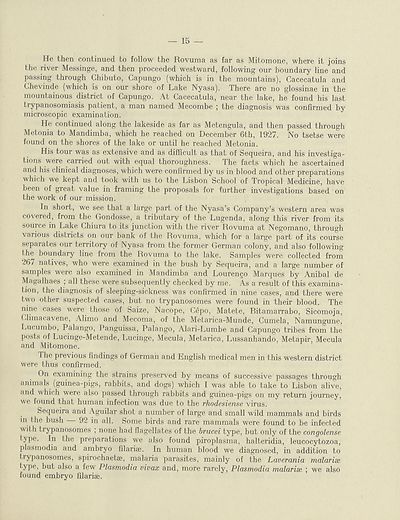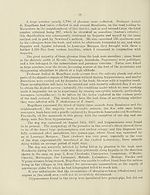Download files
Complete book:
Individual page:
Thumbnail gallery: Grid view | List view

— 15 —
He then continued to follow the Rovuma as far as Mitomone, where it joins
the river Messinge, and then proceeded westward, following our boundary line and
passing through Chibuto, Capungo (which is in the mountains), Cacecatula and
Ghevinde (which is on our shore of Lake Nyasa). There are no glossinae in the
mountainous district of Capungo. At Cacecatula, near the lake, he found his last
trypanosomiasis patient, a man named Mecombe ; the diagnosis was confirmed by
microscopic examination.
He continued along the lakeside as far as Metengula, and then passed through
Metonia to Mandimba, which he reached on December 6th, 1927. No tsetse were
found on the shores of the lake or until he reached Metonia.
His tour was as extensive and as difficult as that of Sequeira, and his investiga¬
tions were carried out with equal thoroughness. The facts which he ascertained
and his clinical diagnoses, which were confirmed by us in blood and other preparations
which we kept and took with us to the Lisbon School of Tropical Medicine, have
been of great value in framing the proposals for further investigations based on
the work of our mission.
In short, we see that a large part of the Nyasa’s Company’s western area was
covered, from the Gondosse, a tributary of the Lugenda, along this river from its
souice in Lake Chiura to its junction with the river Rovuma at Negomano, through
\ arious districts on our bank of the Rovuma, which for a large part of its course
separates our territory of Nyasa from the former German colony, and also following
the boundary line from the Rovuma to the lake. Samples were collected from
267 natives, who were examined in the bush by Sequeira, and a large number of
samples were also examined in Mandimba and Lourengo Marques by Anibal de
Magalhaes ; all these were subsequently checked by me. As a result of this examina¬
tion, the diagnosis of sleeping-sickness was confirmed in nine cases, and there were
two other suspected cases, but no trypanosomes were found in their blood. The
nine cases were those of Saize, Nacope, Cepo, Matete, Bitamarrabo, Sicomoja,
Climacavene, Alimo and Mecoma, of the Metarica-Munde, Cumela, Namungune,
Lucumbo, Palango, Panguissa, Palango, Alari-Lumbe and Capungo tribes from the
posts of Lucinge-Metende, Lucinge, Mecula, Metarica, Lussanhando, Metapir, Mecula
and Mitomone.
The previous findings of German and English medical men in this western district
were thus confirmed.
On examining the strains preserved by means of successive passages through
animals (guinea-pigs, rabbits, and dogs) which I was able to take to Lisbon alive,
and which were also passed through rabbits and guinea-pigs on my return journey,
we found that human infection was due to the rhodesiense virus.
Sequeira and Aguilar shot a number of large and small wild mammals and birds
in the bush 92 in all. Some birds and rare mammals were found to be infected
with trypanosomes ; none had flagellates of the brucei type, but only of the congolense
type. In the preparations we also found piroplasma, halteridia, leucocytozoa,
plasmodia and ambryo filarise. In human blood we diagnosed, in addition to
trypanosomes, spirochaetse, malaria parasites, mainly of the Laverania malarise
type, but also a few Plasmodia vivax and, more rarely, Plasmodia malarise ; we also
found embryo filariae.
He then continued to follow the Rovuma as far as Mitomone, where it joins
the river Messinge, and then proceeded westward, following our boundary line and
passing through Chibuto, Capungo (which is in the mountains), Cacecatula and
Ghevinde (which is on our shore of Lake Nyasa). There are no glossinae in the
mountainous district of Capungo. At Cacecatula, near the lake, he found his last
trypanosomiasis patient, a man named Mecombe ; the diagnosis was confirmed by
microscopic examination.
He continued along the lakeside as far as Metengula, and then passed through
Metonia to Mandimba, which he reached on December 6th, 1927. No tsetse were
found on the shores of the lake or until he reached Metonia.
His tour was as extensive and as difficult as that of Sequeira, and his investiga¬
tions were carried out with equal thoroughness. The facts which he ascertained
and his clinical diagnoses, which were confirmed by us in blood and other preparations
which we kept and took with us to the Lisbon School of Tropical Medicine, have
been of great value in framing the proposals for further investigations based on
the work of our mission.
In short, we see that a large part of the Nyasa’s Company’s western area was
covered, from the Gondosse, a tributary of the Lugenda, along this river from its
souice in Lake Chiura to its junction with the river Rovuma at Negomano, through
\ arious districts on our bank of the Rovuma, which for a large part of its course
separates our territory of Nyasa from the former German colony, and also following
the boundary line from the Rovuma to the lake. Samples were collected from
267 natives, who were examined in the bush by Sequeira, and a large number of
samples were also examined in Mandimba and Lourengo Marques by Anibal de
Magalhaes ; all these were subsequently checked by me. As a result of this examina¬
tion, the diagnosis of sleeping-sickness was confirmed in nine cases, and there were
two other suspected cases, but no trypanosomes were found in their blood. The
nine cases were those of Saize, Nacope, Cepo, Matete, Bitamarrabo, Sicomoja,
Climacavene, Alimo and Mecoma, of the Metarica-Munde, Cumela, Namungune,
Lucumbo, Palango, Panguissa, Palango, Alari-Lumbe and Capungo tribes from the
posts of Lucinge-Metende, Lucinge, Mecula, Metarica, Lussanhando, Metapir, Mecula
and Mitomone.
The previous findings of German and English medical men in this western district
were thus confirmed.
On examining the strains preserved by means of successive passages through
animals (guinea-pigs, rabbits, and dogs) which I was able to take to Lisbon alive,
and which were also passed through rabbits and guinea-pigs on my return journey,
we found that human infection was due to the rhodesiense virus.
Sequeira and Aguilar shot a number of large and small wild mammals and birds
in the bush 92 in all. Some birds and rare mammals were found to be infected
with trypanosomes ; none had flagellates of the brucei type, but only of the congolense
type. In the preparations we also found piroplasma, halteridia, leucocytozoa,
plasmodia and ambryo filarise. In human blood we diagnosed, in addition to
trypanosomes, spirochaetse, malaria parasites, mainly of the Laverania malarise
type, but also a few Plasmodia vivax and, more rarely, Plasmodia malarise ; we also
found embryo filariae.
Set display mode to:
![]() Universal Viewer |
Universal Viewer | ![]() Mirador |
Large image | Transcription
Mirador |
Large image | Transcription
Images and transcriptions on this page, including medium image downloads, may be used under the Creative Commons Attribution 4.0 International Licence unless otherwise stated. ![]()
| League of Nations > Health > Investigations on human trypanosomiasis in Mozambique > (17) |
|---|
| Permanent URL | https://digital.nls.uk/191818343 |
|---|
| Shelfmark | LN.III |
|---|---|
| Description | Over 1,200 documents from the non-political organs of the League of Nations that dealt with health, disarmament, economic and financial matters for the duration of the League (1919-1945). Also online are statistical bulletins, essential facts, and an overview of the League by the first Secretary General, Sir Eric Drummond. These items are part of the Official Publications collection at the National Library of Scotland. |
|---|---|
| Additional NLS resources: |
|

